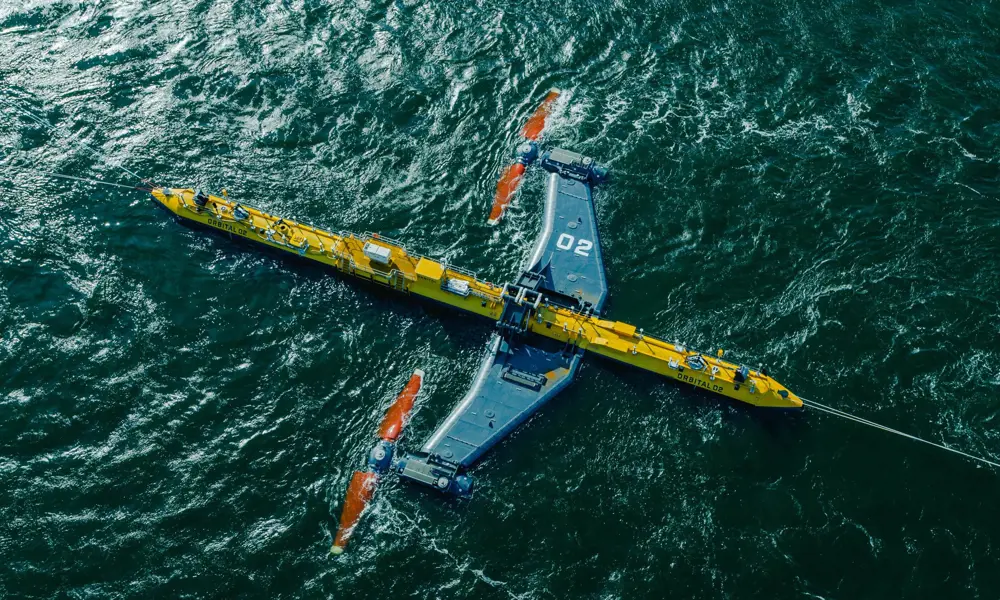
Making sure tidal power blades are fit for purpose
Did you know?
🌊 Why the UK is great for tidal power
- Tidal power is a renewable and predictable energy source – tides can be accurately forecast throughout the year
- The UK has the second-strongest tides in the world – after Canada – so could be an ideal place for tidal power generation
- A 2021 study led by the University of Plymouth found that tidal stream power has the potential to deliver 11% of the UK’s current annual electricity demand
Might tidal power generation be on the verge of rising? Gas, coal, nuclear, hydro, solar, and wind have all featured in the continuing debate about the strengths and weaknesses, costs, and benefits of different electricity sources. But tidal power has been largely absent from the discussion – no surprise given its, so far, tiny contribution. This neglect could change following the opening of a new facility managed by the University of Edinburgh School of Engineering.
Called FastBlade, it has been built at a cost of £4.6 million to test large turbine blades of the kind used to extract energy from tidal flows. To mix a metaphor, the opening of FastBlade in May 2022 could be a straw in the wind: a hint that tidal power is on the turn.
The potential of tidal power in the UK
Wind power accounts for slightly more than a quarter of the electricity generated in the UK. That wind rather than water should have been a preferred source of renewable energy is understandable. Wind, a low hanging fruit among renewables, is widely available. Wind turbines are relatively straightforward to build and to access for maintenance. By contrast, tidal currents strong enough to provide usable energy at a reasonable cost are relatively uncommon. Tidal turbines have been (and still are) expensive, and harder to install and maintain. So, Europe’s tidal streams remain barely tapped – and roughly half of them lie in UK waters.
There are several options for tapping the power of the tides. The most familiar, known as tidal range, is by building a barrage across an estuary or creating an artificial lagoon. As water flows in and out of the lagoon, it travels through channels fitted with turbines.
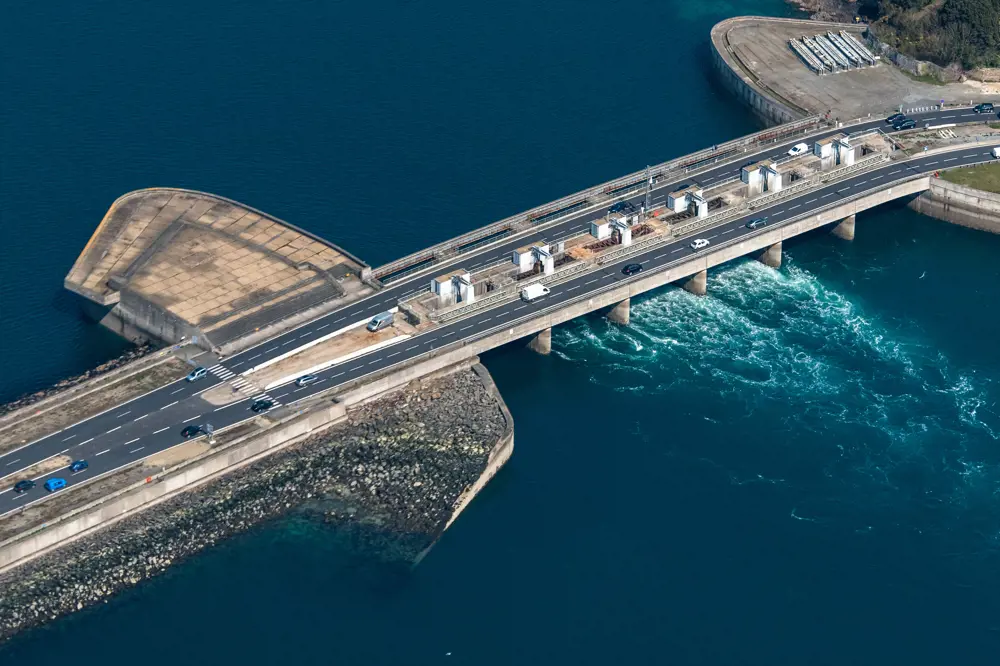
An aerial view of the tidal power station on the estuary of the Rance River, which supplies 0.12% of France’s power demand. It generates power by channelling water through turbines when the held water level is higher than in the tidal estuary. A main road also crosses the dam, allowing vehicles to travel between Dinard and Saint-Malo © Shutterstock
One of the oldest tidal lagoons is on the estuary of the Rance River in Brittany, France. Opened in 1966, Rance Tidal Power Station has a peak output of 240 megawatts (MW) from 24 turbines. It was the world’s largest tidal power station until 2011 when the Sihwa Lake Tidal Power Station opened in South Korea, with a total power output capacity of 254 MW.
The geography of the UK’s Bristol Channel and Severn Estuary has prompted proposals for a barrage linking its English and Welsh sides, or for a tidal lagoon constructed off a section of the South Wales coast. These major engineering projects have so far been rejected on grounds of cost or damage to the environment or both.
There are several alternatives to barrages when it comes to tapping tidal energy. One approach is tidal streaming, which operates in deeper water and generates power using natural currents that occur as the tide changes. It relies on an underwater equivalent of the wind turbine. An upright pillar holds the rotor up above the seabed. As the tide ebbs and flows, so the rotor turns. An alternative approach is the floating turbine, with rotors suspended beneath a securely moored float. One current project that uses this approach is the O2 prototype built by Orbital Marine Power. With a capacity of 2 MW, Orbital describes the O2 as ‘the most powerful tidal turbine in the world’.
In 2021, the Proceedings of the Royal Society published a review of tidal energy production in the UK. This identified just 10.4 MW of installed and operational generating capacity. Setting that beside the more than 300 Terrawatt-hours (TWh) of electricity that the UK generates every year underlines the still minuscule contribution of tidal streams. But, as the report’s authors point out, the future could be markedly different. They estimate that tidal streams could yield 34 TWh/year for the UK, equivalent to more than 10% of current electricity demand.
Tidal streaming depends on technologies that have yet to reach the commercial maturity of wind turbines. In reaching any such goal, a facility such as FastBlade would play an essential role, not least because blade failure is the most likely cause of downtime in generation.
Tidal streaming depends on technologies that have yet to reach the commercial maturity of wind turbines. In reaching any such goal, a facility such as FastBlade would play an essential role, not least because blade failure is the most likely cause of downtime in generation.
Tidal turbine blades are usually made of carbon or glass fibre. Typically 8 to 10 metres long, they are shorter and stiffer than wind turbine blades. This difference is needed because water is much denser than air and each blade must cope with a greater load per unit length. Testing for strength and suitability of design is essential.
Floating turbines helping to power Orkney
One of the current generations of tidal turbines that has attracted much interest is the Orbital O2. A floating machine, it was built in Dundee in 2021 by the Scottish renewable energy company Orbital Marine Power, and then towed to its present location at the European Marine Energy Centre (EMEC) Fall of Warness site, off the Island of Eday.
The mooring site is an area where the Atlantic Ocean meets the North Sea, which is known for its fast-flowing tidal currents.
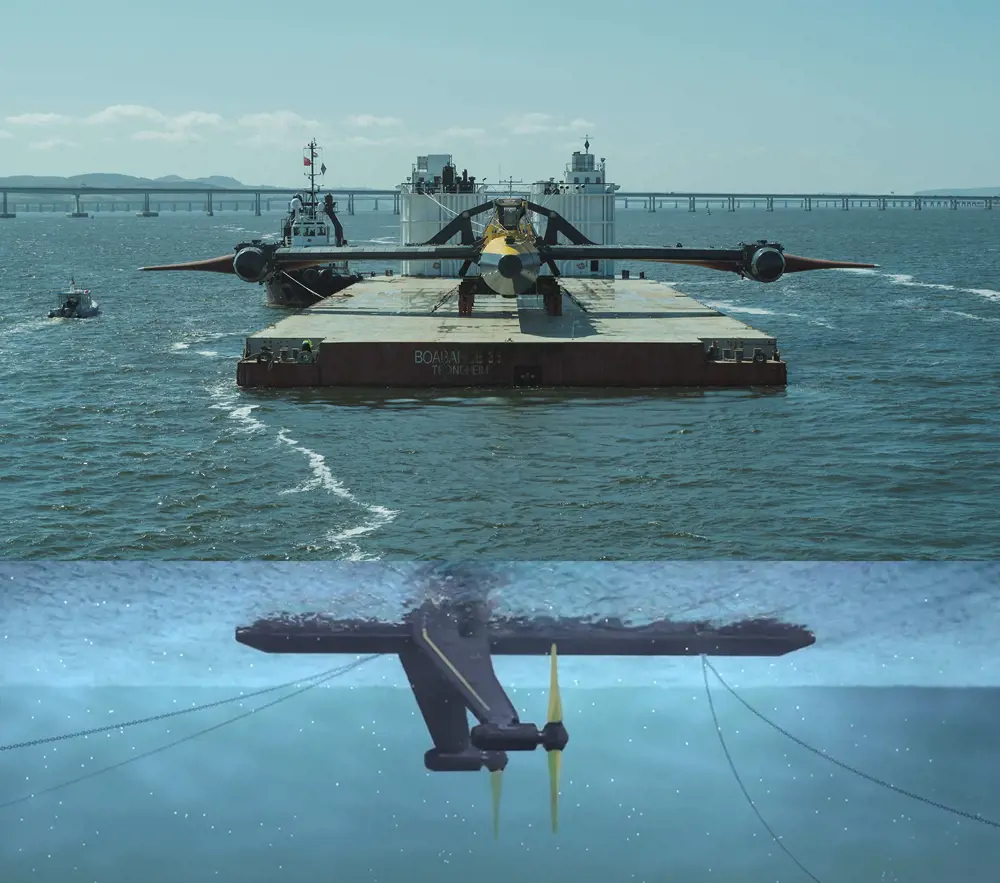
The O2 out of the water and how it looks when placed in the water, with the legs holding the rotors positioned downwards, below the sea surface © Orbital Marine Power
The O2 comprises two rotors with a total surface area of 600 m2, the largest ever on a floating tidal turbine. Both rotors are 20 metres in diameter and mounted on 18-metre-long hinged legs projecting, one on either side, from a 74-metre-long floating tubular platform.
Out of the water the O2 looks like a long thin-bodied aircraft fitted with wings and oversize propellers. When immersed in the sea, and in action, the hinged legs holding the rotors are angled downward from the float at roughly 50° so that the rotors are below the sea surface and in the fastest-flowing region of the tidal current. Bringing the arms back horizontally raises the rotors to the surface for inspection and maintenance.
The turbine is anchored in position by four chains attached to the seabed. The rotor blades can be pitched at 360°, avoiding any need to reorient the platform with each turn of the tide.
The O2 has been operational and exporting electricity to the Orkney grid since July 2021. It is expected to offset about 2,000 tonnes of CO2 each year and power 1,700 UK homes.
Thus far O2 has lived up to expectations, presented no unanticipated problems, and is planned to remain in operation for 15 to 20 years. During this time, it will be integrated with a hydrogen production facility and battery storage at EMEC to create ‘green hydrogen’, part of a plan to bring a full-blown hydrogen economy to the Orkney Islands.
How to make sure turbine blades are fit for purpose
FastBlade bills itself as “the world’s first rapid and superefficient testing facility for tidal turbine blades and other composite structures”. While it can be used for other applications – ranging from aerospace to bridge building – as the name suggests, FastBlade’s planners always had fatigue testing of tidal turbine blades in mind.
FastBlade is the outcome of a partnership between the University of Edinburgh and the engineering company Babcock International, with the support of a £1.8 million grant from the Engineering and Physical Sciences Research Council (EPSRC), and is located in Fife’s Rosyth Dockyard.
Formally opened in May 2022, FastBlade’s centrepiece is a large test hall that houses the rig to which blades are attached. They are then subjected to an accelerated simulation of the loads that blades would have to bear during a lifetime of peak tidal flows. Two overhead 10 tonne travelling cranes can lift blades from the delivery vehicle and lower them on to the test rig.
FastBlade bills itself as “the world’s first rapid and superefficient testing facility for tidal turbine blades and other composite structures".
The rig itself, sunk more than two metres into the ground, is a steel structure that is 12 metres long and 2.5 metres wide. Testing is carried out on single blades. At one end of the rig is a vertical steel wall to which a blade for testing can be bolted horizontally and parallel to the long axis of the underlying base. The structure is designed, for obvious reasons, to be rigid. Any small residual bending it may exhibit has been accounted for during the rig’s initial calibration.
During a test, hydraulic rams apply loading stresses, designed to stimulate the force of the tidal flow, to the blade from beneath. The use of rams to apply the stress is necessary because of the shortness and relative rigidity of tidal turbine blades. Resonance testing – with blades induced to resonate under their own mass without the application of external pressure to bend them – is effective only with the longer, lighter, and less rigid blades of wind turbines.
FastBlade’s rams use hydraulic pumps, operating at a rate of 800 litres per minute, to deliver the loads on the blades. Regenerative hydraulic technology – its first use in a test facility of this kind – recovers energy between cycles to reduce the energy consumed.
Regenerative hydraulic technology
🔃 How regenerative technology is used in blade testing
In a conventional system, the pressurised fluid that drives the forward movement of the rams is simply allowed, between each stroke, to return to atmospheric. In a regenerative system, as the fluid depressurises it repressurises the fluid driving the pump’s next movement. This recovers some 80% of the required energy, which makes for less expensive testing.
Each cycle of loading and unloading represents one rise and fall of the tide. The rig can complete a cycle in a second. In practice, it will take three to four months to simulate the stresses of 20 to 25 years’ continuous use of a blade, and to perform other tests, such as the extra loading that wave action or turbulence might cause. A full test programme might require as many as 10 million cycles. The system is set up to use four hydraulic rams, which will typically be used when testing a turbine blade. Other objects being tested might need differently distributed or greater loading so extra rams can be added as required.
Sensors distributed across a blade’s surface allow investigators to measure and record a blade’s response to stresses. Accelerometers, position monitors, and strain gauges measure how blades respond to repeated loading. To generate digital images, pairs of cameras focus on a random spectral pattern sprayed onto the surface of the blade through a computer-generated stencil. 3D images of the blades’ motion are then used to develop computer models.
FastBlade can also conduct static tests to assess blade stiffness and the extent to which they may deform under load. Such testing can reveal potential weaknesses and can indicate possible improvements in the design of future blades. In addition, testing blades at the end of their working lives can show how used blades have coped with the real-life stresses of years spent under load in the sea.
FastBlade hosted its inaugural tests on a decommissioned blade from the Deepgen III 1 MW prototype tidal turbine. The project, LoadTide, subjected a 5.25 metre blade to a sequence of tests. Provided by the European Marine Energy Centre and made by Tidal Generation Limited, the blade came from an earlier tidal energy project. Before the research team could start testing the blade it had to remove a protective layer of antifouling coating. The blade survived a series of more than 30,000 cycles, the equivalent of about 22 years of accelerated fatigue loading.
As part of the initial run of testing, FastBlade could fully commission the unique digital displacement hydraulic system as well as the bespoke control software. FastBlade plans to use the lessons learned from the LoadTide project to further improve both the controllability and energy efficiency of future tests.

(Left) The FastBlade system in action, with a tidal blade in place, ready to be tested. (Right) A close up of the speckle pattern applied onto the blade’s surface © FastBlade
Each cycle of loading and unloading represents one rise and fall of the tide. The rig can complete a cycle in a second. In practice, it will take three to four months to simulate the stresses of 20 to 25 years’ continuous use of a blade, and to perform other tests, such as the extra loading that wave action or turbulence might cause. A full test programme might require as many as 10 million cycles. The system is set up to use four hydraulic rams, which will typically be used when testing a turbine blade. Other objects being tested might need differently distributed or greater loading so extra rams can be added as required.
Sensors distributed across a blade’s surface allow investigators to measure and record a blade’s response to stresses. Accelerometers, position monitors, and strain gauges measure how blades respond to repeated loading. To generate digital images, pairs of cameras focus on a random spectral pattern sprayed onto the surface of the blade through a computer-generated stencil. 3D images of the blades’ motion are then used to develop computer models.
FastBlade can also conduct static tests to assess blade stiffness and the extent to which they may deform under load. Such testing can reveal potential weaknesses and can indicate possible improvements in the design of future blades. In addition, testing blades at the end of their working lives can show how used blades have coped with the real-life stresses of years spent under load in the sea.
FastBlade hosted its inaugural tests on a decommissioned blade from the Deepgen III 1 MW prototype tidal turbine. The project, LoadTide, subjected a 5.25 metre blade to a sequence of tests. Provided by the European Marine Energy Centre and made by Tidal Generation Limited, the blade came from an earlier tidal energy project. Before the research team could start testing the blade it had to remove a protective layer of antifouling coating. The blade survived a series of more than 30,000 cycles, the equivalent of about 22 years of accelerated fatigue loading.
As part of the initial run of testing, FastBlade could fully commission the unique digital displacement hydraulic system as well as the bespoke control software. FastBlade plans to use the lessons learned from the LoadTide project to further improve both the controllability and energy efficiency of future tests.
Levelling up tidal power for the future
At present, tidal stream power is more costly than wind power. The standard metric for comparing the economic performance of different generating methods is the levelised cost of energy (LCoE). This is the ratio of the total lifetime cost of a project to the energy output over that lifetime.
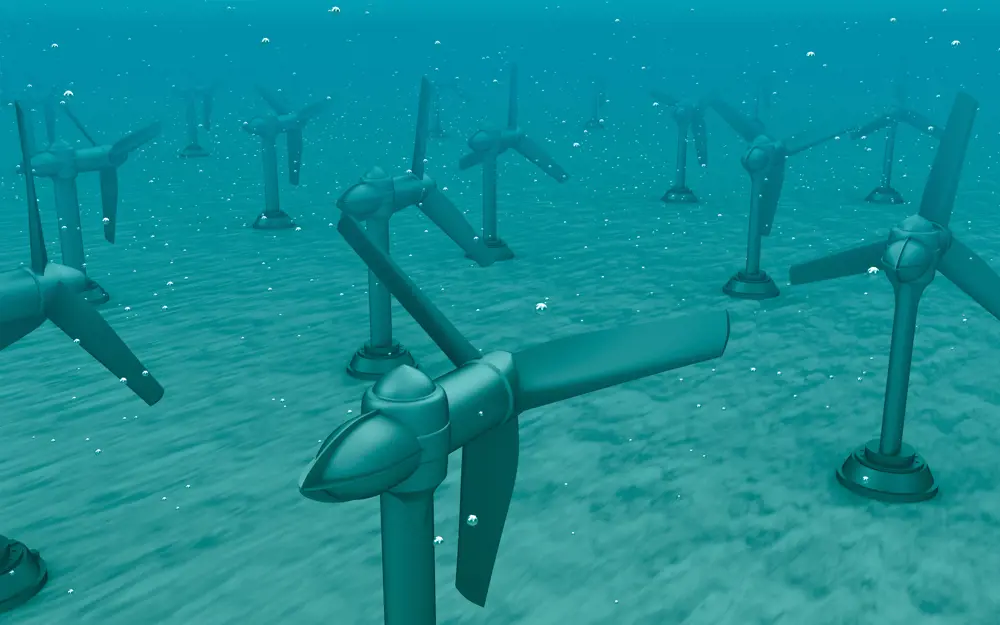
Under water turbines © shutterstock
While offshore wind currently costs about £37 per MWh, tidal comes in at something under £200 per MWh. Dr Daniel Coles, a research fellow in the School of Engineering, Computing and Mathematics at the University of Plymouth and lead author of the Royal Society review paper, is among those who have reservations about LCoE methodology. They believe that it disregards the whole system costs (the changes in the costs of constructing and operating an entire power system resulting from adding a new technology) that renewable power projects incur, as well as the wider socioeconomic benefits that come with the development of a new technology. But he is optimistic. “The cost of tidal energy is now coming down at a much steeper rate than those of wind and solar,” he points out. “These cost reductions are driven by learning and technology development.” With their earlier adoption, wind and solar have already reaped the benefits of this rapid cost reduction phase.
A weakness of most renewable energy sources is their inability to provide a round-the-clock base load. This is also true of tidal power, which also varies, but it does offer total predictability. Unlike the sun and wind, tides are reliable, almost like clockwork. No other renewable energy technology can guarantee a particular power output at a certain hour of the day or night on a date, years into the future.
The full potential of tidal turbines will not be realised until there is sufficient confidence to deploy them not in ones or twos but in multi-megawatt arrays, much as already happens with offshore wind turbine farms. The European Union (EU) is one of the prominent current backers of the technology.
No other renewable energy technology can guarantee a particular power output at a certain hour of the day or night on a date, years into the future.
In line with its green policies, the EU’s €26.7 million FORWARD-2030 project aims to accelerate the commercial deployment of tidal energy alongside wind generation, battery storage, and green hydrogen production. Its objectives are to reduce the LCoE of tidal energy, enhance its environmental and societal acceptance, prepare for future volume manufacturing of equipment, further reduce carbon emissions, and enhance tidal power’s integration with other energy systems. The scheme is supported by a pan- European consortium and led by Orbital Marine.
While arrays of tidal turbines are likely to find a place in the overall mix of energy sources, it is difficult to predict how soon this will happen, or to what extent. Enthusiasts speak of new green jobs, export opportunities, and economic benefits to coastal communities, and point to a clutch of international tidal stream projects with upbeat acronymic titles such as TIGER and ELEMENT. But realists will remain conscious of a further comment from Dr Daniel Coles: “To really accelerate and grow, [tidal] is going to need what the wind and solar industries have benefited from, which is continuous and reliable subsidy support for the next 10 to 15 years.”
***
This article has been adapted from "Tidal power on the turn", which originally appeared in the print edition of Ingenia 93 (December 2022).
Contributors
Geoff Watts
Author
Dr Daniel Coles is a senior research fellow in the Tidal Stream Industry Energiser (TIGER) project, now based at the University of Plymouth.
Dr Fergus Cuthill is the FastBlade Manager and Senior Experimental Officer for the FASTBLADE Structural Composites Research Facility at The University of Edinburgh.
Keep up-to-date with Ingenia for free
SubscribeRelated content
Energy

Algae-powered architecture
An apartment block in Hamburg in Germany has been built that uses microalgae placed within its façade to generate heat and biomass. Jan Wurm, an associate director at Arup, was one of the chief designers of the energy system. He talked about the concept, execution and results from the world’s first photobioreactor.
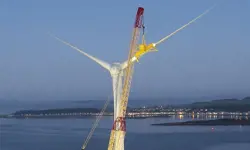
Digital hydraulics for wind energy and beyond
Research that has helped change the technology for harnessing wind energy has many other applications. The digital hydraulics system devised by Artemis Intelligent Power has received many accolades, the latest being the winner of the 2015 MacRobert Award.
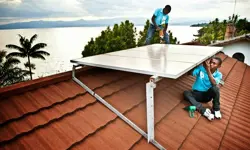
New energy pioneers
London-based BBOXX supplies solar-powered battery boxes to customers in developing countries. Their remote monitoring and battery management system was one of the winners of the 2015 Bloomberg New Energy Finance Award.

Energy with connections
When Steve Holliday FREng moved from the oil industry into energy distribution, the sector was seen as staid. In reality, during his years at National Grid, the sector became increasingly important as the need to tackle climate change led to a transformation in the UK’s energy mix.
Other content from Ingenia
Quick read

- Environment & sustainability
- Opinion
A young engineer’s perspective on the good, the bad and the ugly of COP27

- Environment & sustainability
- Issue 95
How do we pay for net zero technologies?
Quick read

- Transport
- Mechanical
- How I got here
Electrifying trains and STEMAZING outreach

- Civil & structural
- Environment & sustainability
- Issue 95